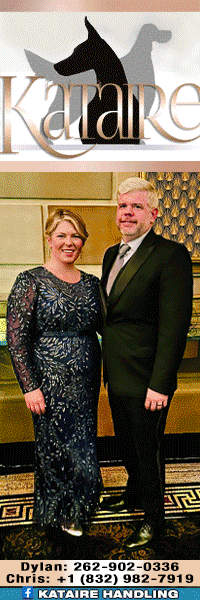What Are They Looking For?

by Lisa Dubé Forman
Communication is truly a lost art form at AKC conformation dog shows. In past ages of our sport, there was considerable respect for the wisdom of our great adjudicators who stood in the show ring emanating commanding appearances. Through their hands they spoke volumes as they examined the dog’s structure and muscling. They silently revealed their thoughts by pausing on faults or virtues with their hands and fingers, and from what I have been told and read, these likes and dislikes were transparent. Slowly, though, this changed and we began to lose many of our qualified arbitrators the sport once enjoyed in abundance. In what epoch did this art of communicating begin to disappear is unbeknownst to me. Perhaps other fanciers with greater than my thirty years in the sport, who socialized in the dog world of old, who knew or were very familiar with the ‘great’ sportsmen and women judges I speak of, are best qualified to answer this question.
Consequently having lost almost all of our ‘great’ judges, this lost art form of communication has left many exhibitors to inquire about the adjudicators, “What are they looking for?” Perhaps you have asked this a hundred times over. More often than not, it is posed rhetorically as a reflection on, or criticism of an observation. We cannot make heads or tails of judges deliberations and decisions leaving us to wonder what we missed.
At today’s AKC conformation dog shows there is no forthcoming judges explanation. As is the common procedure, judges quickly, in a cloak of secrecy, flick fingers at placements and awards and rush off to fill out their judging book. They hand out the satin ribbons and finito! They are on to the next breed. There is no accountability. We can solve this vexing, discouraging issue while infusing credibility back into the all-breed adjudication process. In recent times there has been debate about adopting a few practices of the Federation Cynologique Internationale (FCI). For instance, we now offer a Reserve Best in Show and although I do not see our classes being restructured, we can and should adopt one highly useful and logical FCI requirement. We need to embrace and demand judge’s critiques and grading on every entry. This is a valuable tool for exhibitors, breeders, judges, as well for AKC Executive Field Representatives. More about this further on.
For those who are unfamiliar with FCI Regulations for Show Judges, the FCI official website states, “The candidate has to produce a consequent critique with the good and less good points of the outline and movement of the dogs and he must pay attention to the health and welfare of the dog.” From there the FCI qualifications given by the judges must correspond to the following definitions:
Excellent may only be awarded to a dog which comes very close to the ideal standard of the breed, which is presented in excellent condition, displays a harmonious, well-balanced temperament, is of high class and has excellent posture. Its superior characteristics in respect of its breed permit that minor imperfections can be ignored; it must, however, have the typical features of its sex.
VERY GOOD may only be awarded to a dog that possesses the typical features of its breed, which has well-balanced proportions and is in correct condition. A few minor faults may be tolerated. This award can only be granted to a dog that shows class.
GOOD is to be awarded to a dog that possesses the main features of its breed. The good points should outweigh the faults so that the dog can be considered a good representative of its breed.
SUFFICIENT should be awarded to a dog which corresponds adequately to its breed, without possessing the generally accepted characteristics or whose physical condition leaves a lot to be desired.
DISQUALIFIED must be awarded to a dog which does not correspond to the type required by the breed standard. This qualification shall also be awarded to dogs that correspond so little to a single feature of the breed that their health is threatened. It should furthermore be awarded to dogs that show disqualifying faults in regard to the breed standard. The reason the dog was rated DISQUALIFIED has to be stated in the judge’s report. {My extraction omitting several other statements listed under the FCI complete disqualification clause}
Mandatory grading and critiques have numerous advantages with the most obvious being the exhibitors receive an instant elucidation on their dog’s virtues and faults. If you have attended FCI dog shows in a foreign country, you are already familiar with the process. For those who have not exhibited on foreign soil, many of us have had a taste of the process while exhibiting under a foreign judge at AKC conformation shows when such judges provide verbal opinions while awarding ribbons. Moreover, I submit that an important consequence of critiques is that it will strengthen the overall quality of our judges pool. When a judge has to grade and explain ‘why they did what they did,’ it may accentuate incompetence. Similarly, this process can benefit judges as well as AKC Executive Field Representatives. Grading with written evaluations can serve as validation for a judge’s awards when confronted by an AKC Field Representative. When questioned, the show judge can produce a grade and written critique of their placements and awards rather than depending on memory in the hopes of preventing an unfair, negative evaluation. Likewise, consequent critiques are tools that may enforce the aforementioned Representative’s evaluation of a permit or regular status judge. Judges would be compelled to include, for the sake of this discussion we use the FCI verbiage, “The good and less good points of the outline and movement of the dogs.” Equally important, the rating of the breeds’ characteristics and typical features, while noting symmetry of parts, or lack thereof. If a judge is unable to identify basic skeletal anatomy and its proper usage when applied to that specific breeds’ function then there is a serious dilemma. Likewise, if they are unaware or unable to identify the distinctive traits for a breed.
I previously discussed in this magazine’s March 2012 article, “Hot Button Issue, When Should Judges Call It Quits?” how some judge’s have betrayed signs of difficulties with execution and quality in their assignments. On the other hand, this is not the only judges segment who have failed in their superintendence within the all-breed show ring. Simply, there are a number of unqualified arbitrators who adjudicate every weekend across our country who have performed in a superficial manner because there are no requirements to qualify their decisions. This is even more apparent with the absenteeism of AKC Executive Field Representatives at many of our all-breed conformation shows. An elaborating and grading process may separate out these judges who have proven to be ineffectual up to now in the show ring. Perhaps even the requirement to qualify decisions may give some of these judges pause, possibly inhibiting their accepting assignments in breeds they are uncertain and/or less confident of, irrelevant if they are regular or permit status in such breed. Especially if these gradings and critiques hold one’s feet to the fire.
In my article, “We are Not Judging Statues,” from The Canine Chronicle April 2012 issue, I touched on the content and quality of judges commentary being vital to the well-being of our sport. Frequently, we hear ridiculously impractical talk, “The dog gave it their all”; “The dog asked for it and could not be denied”; “The dog was so on”; “The dog has attitude.” In like fashion, these statements are seemingly used as a veil the judge hides behind, they put on an air of indignation and are dismissive towards an exhibitor or spectator who dares to inquire after the meaning of their gibberish. Compulsory critiques and grading would be wonderfully communicative for the exhibitor revealing the extent of a judge’s breed knowledge. In like manner, this practice can also be beneficial for the judge, and can serve as a protective measure for differences of opinion or as I call it, the right of quality of selection.
To illustrate, there are a number of features in various breed standards, some breed standards include a scale of points in which some traits are rated proportionately. With all other things being equal or nearly as possible, a judge may value one such feature more highly than their counterpart judge. Hence, one judge may award, based on their estimation of an attribute they consider more important, another dog over its competitor who won under another judge. The subsequent grading and evaluation makes this explicit and clear. The exhibitor then has solid information why the judge did what they did, the exhibitor can agree with it or not but at least they are informed and not left asking, “What are they looking for?”
In FCI membership countries, exhibitors are accustomed and expect to hear commentary of virtues and faults on their dogs. In contrast, the United States does have exhibitors who do not wish to hear why they lost, their mannerisms speaking volumes. Even more, some exhibitors are hostile. Every judge has had situations arise similar to the following. When handing a second place ribbon to an exhibitor, I noted her sighthound’s virtues but the obvious, unsatisfactory feature was the hound’s extreme short-leggedness. This exhibitor hissed furiously, “But she’s to standard!” Such statements are not only illuminating but also sad. The breeder did not understand that disproportionate, atypical, short legs and conforming to breed standard heights are exclusive of one another. A separate but similar interaction occurred involving a professional handler whose exhibit was yet another short-legged sighthound. Instead of pausing for a moment to hear a valuable critique from a judge who they knew was a long-time breed authority, the handler grabbed the ribbon muttering indecipherably, and stormed out the ring nearly running over other exhibitors.
Our sport most certainly does not need role models such as these who display unsporting behavior. Possibly we can educate the ignorant and weed the bad apples out when adopting this FCI regulation. Those who are solely motivated by paychecks or the unqualified breeders like the one above who purposefully denies her sighthound breed’s fundamental attributes may do one of several things. They may be humbled and improve their stock, the other might be selective in representing higher quality charges, or they will leave the sport. These two brief examples suggest the uphill battle we judges might wage while implementing a very powerful learning tool of mandatory grading and critiques. Is it worth it? Hell yes! Because the breeds, therefore the dogs are worth the torment.
Short URL: http://caninechronicle.com/?p=12388
Comments are closed











